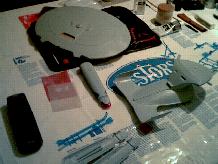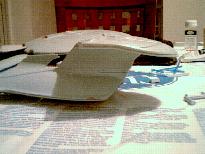|
I got to learn about using putty, today... Last
night I put it on parts of the rear engineering section where the part forming
die put a terrible indentation in it - fixed that right up (lost some of the
plastic detailing, but that's alright).
I put it in the shuttle bay doors, so that the inside
was the same thickness as the outside of the door - more complicated, but
necessary work I think. On the other hand, I didn't paint anything inside
(the shuttle bays are going to be very plain on this one, which is, of course,
just fine). If I had (as I intend to for the Voyager's shuttle bay), it
would be much more complicated. I'm contemplating how that's going to go
over. Hopefully the Voyager's parts will fit together better...
I also used putty on the bridge, as there were millimetre
gaps around the whole thing. I learned not to use hole-filling putty for millimetre
gaps! It was harder than hell to file down without scoring the plastic -
putty wasn't made for that fine of detail without a SHITLOAD more work than I
was willing to put into that! I'm thinking that just using cement and
using capillarity would have worked a lot better. Where the lower hull
meets the engineering section, there is another long millimetre gap - I'll try
the cement idea there.
----
I wrote the above after working on it for fifteen
minutes. Now it's four hours later - here's where I am:

Assembly of the warp nacelle was a major
pain in the ass, and terrible disappointment - if I was serious about this kit
I'd be pissed - I'm missing the primary impulse cover (transparent red) I
have the saucer section impulse covers (transparent blue, they're supposed to be
red) and the transparent blue strips for the nacelles are at least a full
centimetre too short! I have been contemplating how I would deal with this
on the Voyager; I'd have to get really creative.
 Assembly of the stardrive section was also quite painful, as the base it
rested on (connecting battle bridge to secondary hull) was in two loose pieces -
difficult to tack in place - and the top piece (battle bridge) was too straight,
resulting in a 30 degree bend to get it to match from primary impulse up to the
forward tip of the assembly. I had to glue strategic places - tacks -
gradually up from the impulse area up until I got to the tip, then go back and
re-enforce the tacks.
Assembly of the stardrive section was also quite painful, as the base it
rested on (connecting battle bridge to secondary hull) was in two loose pieces -
difficult to tack in place - and the top piece (battle bridge) was too straight,
resulting in a 30 degree bend to get it to match from primary impulse up to the
forward tip of the assembly. I had to glue strategic places - tacks -
gradually up from the impulse area up until I got to the tip, then go back and
re-enforce the tacks.
The idea of using cement to fill in millimetre
gaps with cement worked pretty well, but it doesn't file as gracefully. To
a limited extent I'd rather use the plastic-melting compound and file it when
it's hardened. This is pretty dangerous, though, and if I use too much it
starts to actually loose basic structure!
As you can tell by the picture above, the
top of the stardrive section is about a centimetre too short - I got a little
crazy with the file.. Definitely not good. This happened because I
didn't appreciate where it sat on the stardrive upper supports (thinking it
would go a bit more forward). Making sure all the pieces fit right is
going to require extensive analysis in the future, can't just go filin' away..
You know what I'm thinking? I'm thinking that I don't
regret this, I know it's all going to be worth it. I'm thinking on top of
this, I'm a computer person, the manager of Network Engineering for a startup
company, and father of one.
I'm thinking that it's a good thing I'm not in a
relationship right now - she'd kick my ass.
|

